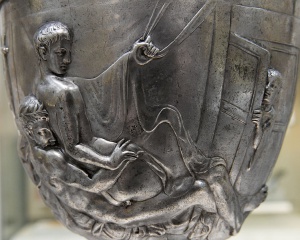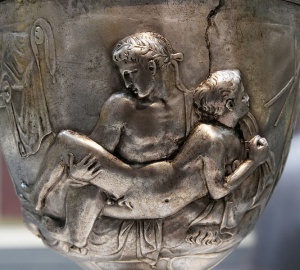Edward Perry Warren


Edward Perry Warren (January 8, 1860 – December 28, 1928), known as Ned Warren, was an American art collector and the author of works proposing an idealized view of homosexual relationships. He is now best known as the former owner of the Warren Cup in the British Museum.
Biography
Warren was born on January 8, 1860, in Waltham, Massachusetts,[1] one of five children born into of a wealthy Boston, Massachusetts family. His father was Samuel Denis Warren, who founded the Cumberland Paper Mills in Maine.[2] He received his B.A. from Harvard College in 1883[1] and later studied at New College, Oxford, earning his M.S. in Classics.[2] His academic interest was classical archeology. At Oxford he met archeologist John Marshall (1862–1928), a younger man he called "Puppy,"[3] with whom he formed a close and long-lasting relationship, though Marshall married in 1907, much to Warren's dismay.[3] Beginning in 1888, Warren made England his primary home. He and Marshall lived together at Lewes House, a large residence in Lewes, East Sussex, where they became the center of a circle of like-minded men interested in art and antiquities who ate together in a dining room overlooked by Lucas Cranach's Adam and Eve, now in the Courtauld Institute of Art. One account said that "Warren's attempts to produce a supposedly Greek and virile way of living into his Sussex home" produced "a comic mixture of apparently monastic severity (no tea or soft chairs allowed) and lavish living."[4]
Warren spent much of his time in Continental Europe, collecting art works many of which he donated to the Museum of Fine Arts, Boston, assembling for that institution the "largest collection of erotic Greek vase paintings " in the U.S.[5] He has been described as having "a taste for pornography" and a "pioneer" in collecting it.[6] His published works include A Defence of Uranian Love in three volumes, which proposes a type of same-sex relationship similar to that prevalent in Classical Greece, in which an older man would act as guide and lover to a younger man.
In 1900 Warren published The Prince who did not Exist, a small edition art book from the Merrymount Press, "a most beautiful specimen of workmanship" according to the New York Times.[7]
Warren's oldest brother, Samuel D. Warren had left law to work in the family's paper mill. He managed the family trust established in May 1889 with the legal assistance of Louis D. Brandeis to benefit his father's widow and 5 children. Edward Warren challenged his brother's administration of the family trust in 1906, a dispute that ended with Samuel's suicide in 1910.[8] The Warren Trust case became a point of contention during the 1916 Senate hearings on the confirmation of Brandeis to the Supreme Court and it remains important for its explication of legal ethics and professional responsibility.[9]
Warren purchased the Roman silver drinking vessel known as the Warren Cup, now in the British Museum, which he did not attempt to sell during his lifetime because of its explicit depiction of homoerotic scenes. He also commissioned a version of The Kiss from Auguste Rodin, which he offered as a gift to the local council in Lewes. The council displayed it for two years before returning it as unsuitable for public display.[2] It is now in the Tate Gallery.[10]
Warren had a home for a time in Gorham, Maine, and Marshall had a home in Rome.[1]
John Marshall's will named Warren as his executor and beneficiary.[1]
In March 1928, Warren gave Lewes House and its adjoining properties to H. Asa Thomas, who had begun as his secretary and become his business associate and friend.[2]
Later that year, Warren became seriously ill and underwent surgery.[2] He died in a London nursing home on December 28, 1928.[1] His ashes were buried in the non-Catholic cemetery in Bagni di Lucca, Italy,[11] a town known as a spa in Etruscan and Roman times.
The disposition of his estate was complicated by legal problems.[12] An auction of some 250 pieces of his furniture brought $38,885.[13] The Sackler Library at Oxford University holds the "Papers of E.P. Warren and John Marshall."[14] Warren's will established the position of EP Warren Praelector at Corpus Christi College, Oxford, and established restrictions, no longer maintained, that ensured the holder lived at or near the College and taught only men.[12]
In 2013, the Boston Museum of Fine Arts determined that a bronze statuette it purchased from Warren in 1904 had been stolen from a French museum in 1901 and arranged for its return.[15]
Select works
- The Prince who did not Exist (1900)
- Classical and American Education (Oxford, B.H. Blackwell, 1918)[16]
- Alcmaeon, Hypermestra, Caeneus (Oxford: B.H. Blackwell, 1919)[17]
- A Tale of Pausanian Love (1927), under the pseudonym Arthur Lyon Raile
- A Defence of Uranian Love, 3 vols. (privately printed, 1928–30), under the pseudonym Arthur Lyon Raile
See also
References
- ↑ 1.0 1.1 1.2 1.3 1.4 New York Times: "Edward Perry Warren," December 30, 1928, accessed October 27, 2011
- ↑ 2.0 2.1 2.2 2.3 2.4 Lewes District Council: "The Story of Lewes House", accessed October 27, 2011
- ↑ 3.0 3.1 BrightonOurStory: Auguste Rodin/Edward Perry Warren," Issue 6, Summer 1999, accessed October 27, 2011
- ↑ New York Times: Herbert W. Horwill, "News and Views of Literary London," August 17, 1941, accessed October 27, 2011. Horwill was reporting Desmond MacCaryhy's review of Burdett and Goddard's biography of Warren in the Times Literary Supplement.
- ↑ New York Times: James R. Mellow, "A new (6th century B.C.) Greek vase for New York," November 12, 1972, accessed October 27, 2011
- ↑ New York Times: Glen Bowersock, "Open House for the Ancients," April 18, 1999, accessed October 27, 2011
- ↑ New York Times: "Artistic Commercial Printing," May 26, 1900, accessed October 27, 2011
- ↑ Martin Green, The Mount Vernon Street Warrens: A Boston Story, 1860-1910 (NY: Scribner's, 1989), 5-10, 83, 193-8
- ↑ John P. Frank, "The Legal Ethics of Louis D. Brandeis," Stanford Law Review, vol. 17, no. 4 (April 1965), 683-709, esp. 694-8
- ↑ New York Times: John Russell, "From Lopsidedness to Limpidity: A Rethought and Renewed Tate," February 14, 1990, accessed October 27, 2011
- ↑ Green, 234
- ↑ 12.0 12.1 Simon Swain, Stephen Harrison, S.J. Harrison, Jas Elsner, eds., Severan Culture (Cambridge University Press, 2007), xxi; R. Symonds, The Fox, the Bees, and the Pelican Worthies and Noteworthies of Corpus Christi College, Oxford (Oxford: Taafe, 1993
- ↑ New York Times: "250 Antiques Sell for $38,885," November 30, 1930, accessed October 27, 2011
- ↑ Sackler Library: "Special Collections and Closed-access Material", accessed October 27, 2011
- ↑ Cook, Greg. "A Roman Statue, Stolen A Century Ago, Is Found At MFA, And Returned", February 1, 2013. Retrieved on June 22, 2013.
- ↑ The Contemporary Review, vol. 114, 701-3 available online, accessed October 27, 2011
- ↑ Archive.org: Alcmaeon, Hypermestra, Caeneus, accessed October 27, 2011